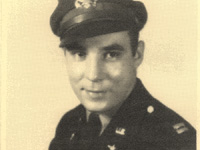| George J. Laben |

George Laben while home on leave, Crown Point, Indiana [3/1945] | World War II, 1939-1946; Cold War Era, 1945-1991; Cold War Era, 1945-1991
Air Force
2nd Troop Carrier Squadron, 343rd Group, 10th Air Force
China-Burma-India (CBI) Theater; United States
Lieutenant Colonel
St. Anne, IL
 |
|
 |
In seventeen months stationed in India and Burma during World War II, George Laben
flew 245 missions in a C-47 transport plane, an aircraft he still praises for its
maneuverability and general ease of flying. He dodged Japanese planes by flying low
enough to the ground to be mistaken for ground cover, and never lost a plane or a crew
member, even though the overall losses in his squadron were enormous. Occasionally, he
flew night missions undercover for the OSS, dropping off men (in parachutes) and
supplies, and on one memorable flight, a half-dozen unauthorized bombs. Laben readily
admits he never took off without feeling some discomfort, though he always believed he
would make it back home from every flight.
|
|

